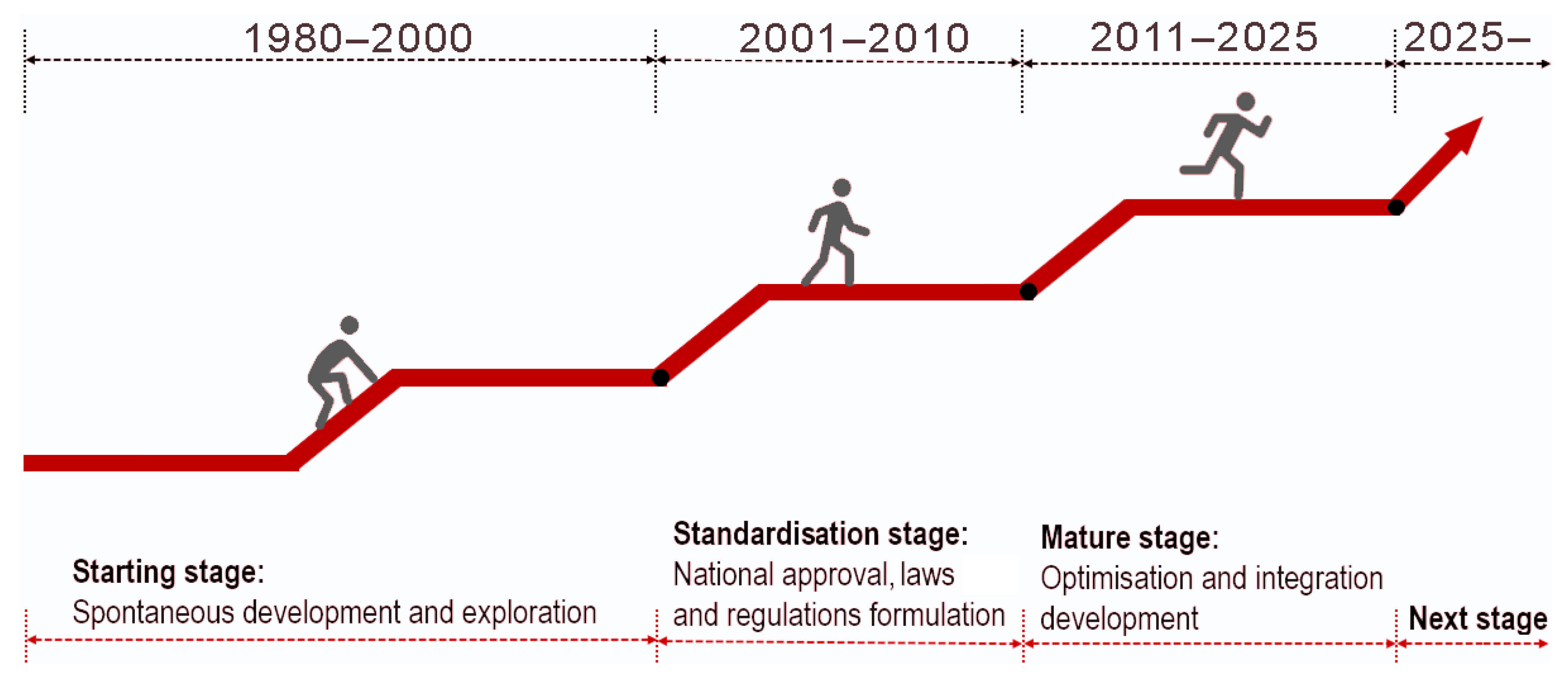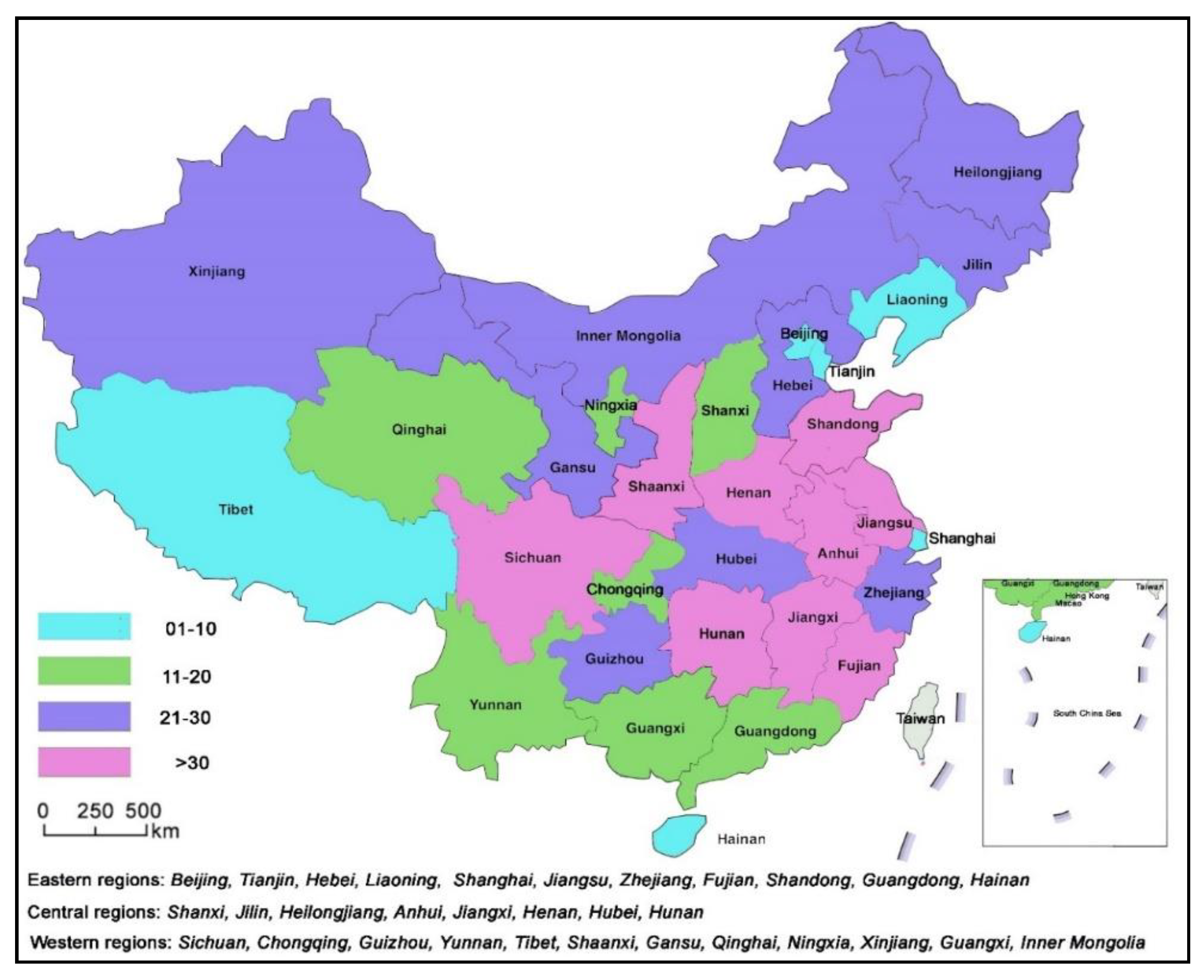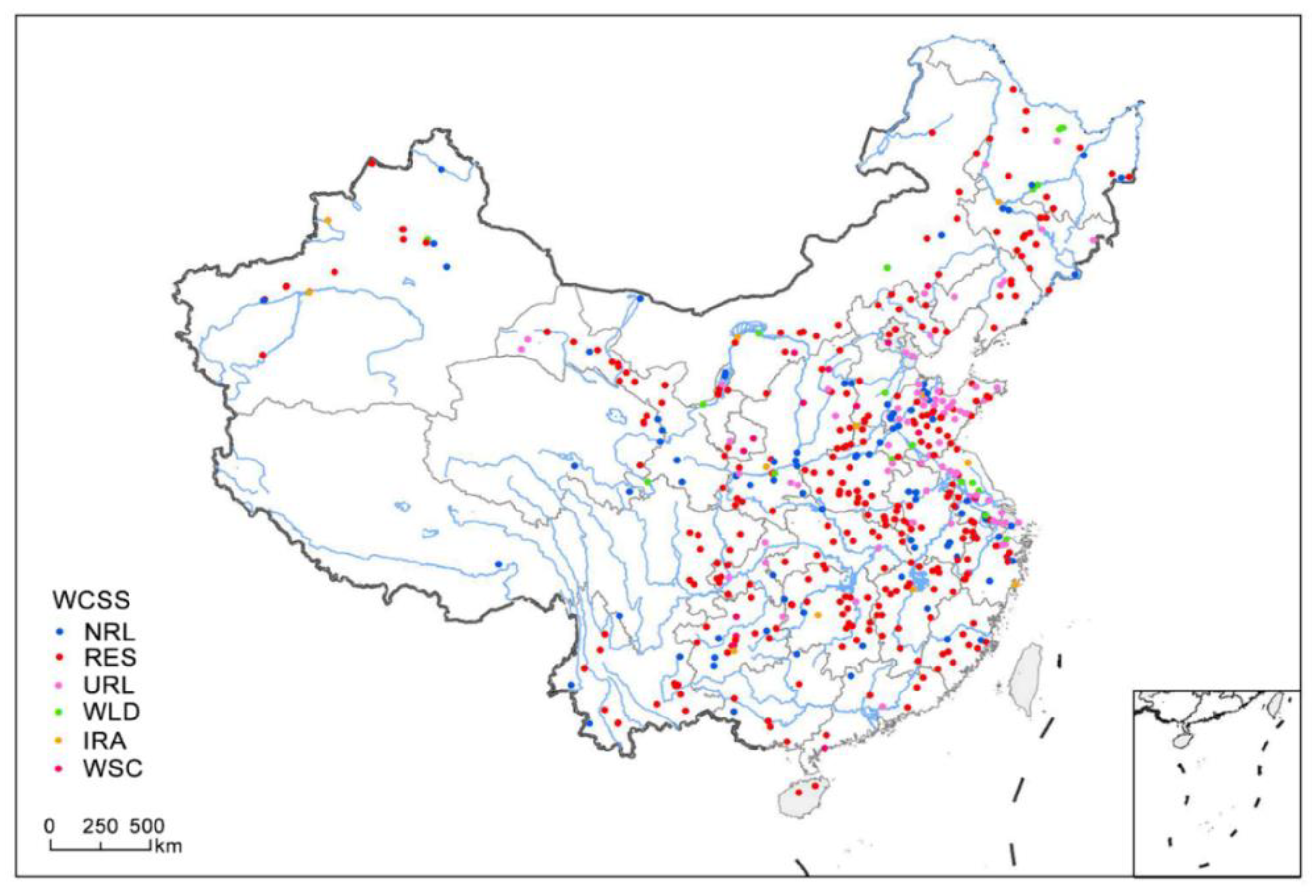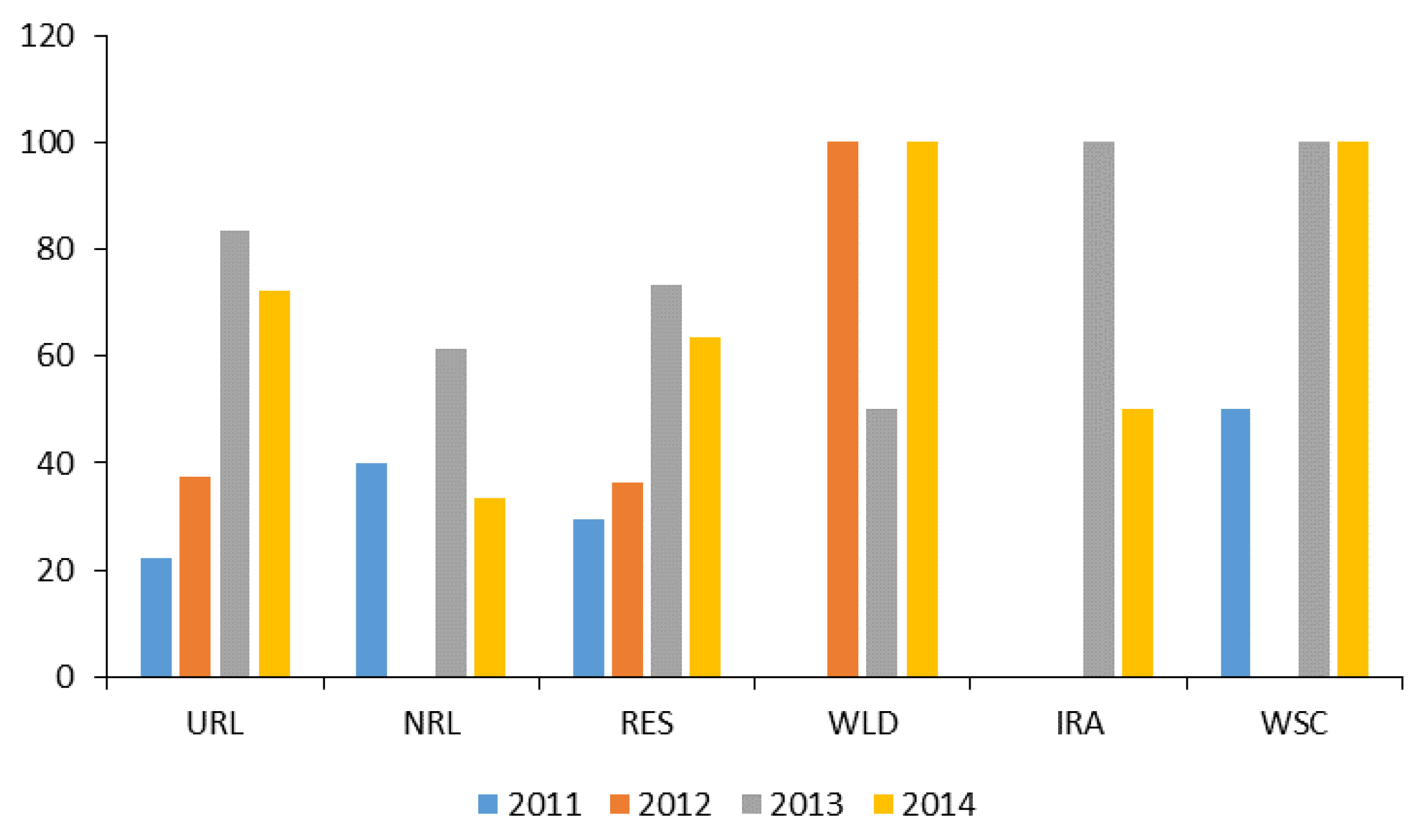Water Conservation Scenic Spots in China: Developing the Tourism Potential of Hydraulic Projects and Water Resources
Abstract
1. Introduction
2. Methodology
3. Concept of the WCSS
3.1. Characteristics and Essence of the WCSS
3.2. Background and Historical Pathway
3.2.1. Starting Stage: Spontaneous Development and Exploration
3.2.2. Standardisation Stage: National Approval, Laws, and Regulation Formulation
3.2.3. Mature Stage: Optimisation and Integration Development
3.3. Contents and Requirements
- Resource investigation;
- Status analysis and evaluation;
- Principle and scope;
- Target year and the task of water conservation planning;
- Functional division of planning layout;
- Special planning;
- Capacity;
- Cost-benefit;
- Environmental assessment.
4. Situations of WCSSs in China
4.1. Temporal Trend
4.2. Category
4.3. Regional Distribution
5. Opportunities and Challenges
5.1. Planning Requirements and Implementation
5.2. Water Conservation Promotion and Possible Damage
5.3. Economic Benefits and Initial Investments
5.4. Water Resource Protection and Ecological Degradation
6. Conclusions and Discussion
6.1. The Problems in the Development of WCSSs
6.2. Suggestions for Planning and Management
Author Contributions
Funding
Acknowledgments
Conflicts of Interest
References
- Daoudi, L.; Saidi, M. Floods in semi-arid zone: Example of the Ourika (High Atlas of Marrakech, Morocco). Int. Sci. J. Altern. Energy Ecol. 2008, 5, 117–123. [Google Scholar]
- Sandesara, U.; Wooten, T. No One Had a Tongue to Speak: The Untold Story of One of History’s Deadliest Floods; Prometheus Books: Amherst, NY, USA, 2011. [Google Scholar]
- Savenije, H.H.G. Water scarcity indicators; the deception of the numbers. Phys. Chem. Earth Part B Hydrol. Oceans Atmos. 2000, 25, 199–204. [Google Scholar] [CrossRef]
- Postel, S.L.; Daily, G.C.; Ehrlich, P.R. Human appropriation of renewable fresh water. Science 1996, 271, 785–788. [Google Scholar] [CrossRef]
- Liu, J.; Zang, C.; Tian, S.; Liu, J.; Yang, H.; Jia, S.; You, L.; Liu, B.; Zhang, M. Water conservancy projects in China: Achievements, challenges and way forward. Glob. Environ. Chang. 2013, 23, 633–643. [Google Scholar] [CrossRef]
- Wang, M.; Zhang, D.Q.; Adhityan, A.; Ng, W.J.; Dong, J.W.; Tan, S.K. Conventional and holistic urban stormwater management in coastal cities: a case study of the practice in Hong Kong and Singapore. Int. J. Water Res. Dev. 2018, 34, 192–212. [Google Scholar] [CrossRef]
- Wang, M.; Zhang, D.; Li, Y.; Hou, Q.; Yu, Y.; Qi, J.; Fu, W.; Dong, J.; Cheng, Y. Effect of a Submerged Zone and Carbon Source on Nutrient and Metal Removal for Stormwater by Bioretention Cells. Water 2018, 10, 1629. [Google Scholar] [CrossRef]
- Xu, X.; Tan, Y.; Yang, G. Environmental impact assessments of the Three Gorges Project in China: Issues and interventions. Earth-Sci. Rev. 2013, 124, 115–125. [Google Scholar] [CrossRef]
- Canter, L.W. Environmental Impact of Water Resource Projects; CRC Press: Boca Raton, FL, USA, 2018. [Google Scholar]
- Wang, M.; Zhang, D.Q.; Su, J.; Dong, J.W.; Tan, S.K. Assessing hydrological effects and performance of low impact development practices based on future scenarios modeling. J. Clean. Prod. 2018, 179, 12–23. [Google Scholar] [CrossRef]
- Chan, F.K.S.; Griffiths, J.A.; Higgitt, D.; Xu, S.; Zhu, F.; Tang, Y.-T.; Xu, Y.; Thorne, C.R. “Sponge City” in China—A breakthrough of planning and flood risk management in the urban context. Land Use Policy 2018, 76, 772–778. [Google Scholar] [CrossRef]
- Romano, B.; Zullo, F. The urban transformation of Italy’s Adriatic coastal strip: Fifty years of unsustainability. Land Use Policy 2014, 38, 26–36. [Google Scholar] [CrossRef]
- Lagarense, B.E.S.; Walansendow, A. Exploring residents’ perceptions and participation on tourism and waterfront development: The case of Manado waterfront development in Indonesia. Asia Pac. J. Tour. Res. 2015, 20, 223–237. [Google Scholar] [CrossRef]
- Theuma, N. Waterfronts and Tourism. In The Fluid City Paradigm; Springer: Cham, Switzerland, 2016. [Google Scholar]
- Cheung, D.M.-W.; Tang, B.-S. Social order, leisure, or tourist attraction? The changing planning missions for waterfront space in Hong Kong. Habitat Int. 2015, 47, 231–240. [Google Scholar] [CrossRef]
- Xie, P.F.; Gu, K. The changing urban morphology: Waterfront redevelopment and event tourism in New Zealand. Tour. Manag. Perspect. 2015, 15, 105–114. [Google Scholar] [CrossRef]
- Mollenkopf, J. The Contested City; Princeton University Press: Princeton, NJ, USA, 1983. [Google Scholar]
- Laidley, J. The ecosystem approach and the global imperative on Toronto’s Central Waterfront. Cities 2007, 24, 259–272. [Google Scholar] [CrossRef]
- Page, S.J. Tourist development in London Docklands in the 1980s and 1990s. GeoJournal 1989, 19, 291–295. [Google Scholar] [CrossRef]
- McCarthy, J. The Dundee waterfront: A missed opportunity for planned regeneration. Land Use Policy 1995, 12, 307–319. [Google Scholar] [CrossRef]
- Dawkins, J.; Colebatch, H. Governing through institutionalised networks: The governance of Sydney Harbour. Land Use Policy 2006, 23, 333–343. [Google Scholar] [CrossRef]
- Craig-Smith, S.J. Recreation and Tourism as a Catalyst for Urban Waterfront Redevelopment: An International Survey; Greenwood Publishing Group: Westport, CT, USA, 1995. [Google Scholar]
- Wang, H. Preliminary investigation of waterfront redevelopment in Chinese coastal port cities: The case of the eastern Dalian port areas. J. Transp. Geogr. 2014, 40, 29–42. [Google Scholar] [CrossRef]
- Vayona, A. Investigating the preferences of individuals in redeveloping waterfronts: The case of the port of Thessaloniki–Greece. Cities 2011, 28, 424–432. [Google Scholar] [CrossRef]
- Madsen, G.E.; Andrews, W.H. New Planning Needs for Recreation Management in Multipurpose Water Resource Projects; Utah State University, Institute for the Study of Outdoor Recreation and Tourism: Logan, UT, USA, 1977. [Google Scholar]
- Duda-Gromada, K. Use of river reservoirs for tourism and recreation case study: Solińskie lake in Poland. Pol. J. Nat. Sci. 2012, 27, 367–376. [Google Scholar]
- Katarzyna, D.; Zoltán, D.; Lóránt, D. Lakes, reservoirs and regional development through some examples in Poland and Hungary. GeoJournal Tour. Geosites Oradea 2010, 1, 16–23. [Google Scholar]
- ArtReefs. Innovative, Competitive and Integrated Tools for Sustainable Coastal Tourism and Inclusive Blue Growth in the Mediterranean and Black Seas; National Tourism Cluster “Bulgarian Guide”: Sofia, Bulgaria, 2015. [Google Scholar]
- Branche, E. The multipurpose water uses of hydropower reservoir: The SHARE concept. Comptes Rendus Phys. 2017, 18, 469–478. [Google Scholar] [CrossRef]
- Branche, E. Sharing the Water Uses of Multipurpose Hydropower Reservoirs: The SHARE Concept; World Water Council: Marseille, France, 2015. [Google Scholar]
- FERC. Environmental Assessment for Hydropower Pilot Project License; Federal Energy Regulatory Commission: Washington, DC, USA, 2013.
- Firoozi, F.; Merrifield, J. An optimal timing model of water reallocation and reservoir construction. Eur. J. Oper. Res. 2003, 145, 165–174. [Google Scholar] [CrossRef]
- Visser, N.; Njuguna, S. Environmental impacts of tourism on the Kenya coast. Ind. Environ. 1992, 15, 42–52. [Google Scholar]
- Vallega, A. Mediterranean action plan: Which futures? Ocean Coast. Manag. 1994, 23, 271–279. [Google Scholar] [CrossRef]
- Wang, Y.; Sheng, L.X.; Li, K.; Sun, H.Y. Analysis of present situation of water resources and countermeasures for sustainable development in China. J. Water Resour. Water Eng. 2008, 19, 10–14. [Google Scholar]
- MWR. Bulletin of the First National Census for Water; Ministry of Water Resources: New Delhi, India, 2013. [Google Scholar]
- MWR. National Plan for Water Conservancy Scenic Spot Construction and Development 2017–2025; Ministry of Water Resource: Beijing, China, 2017. [Google Scholar]
- He, B.J.; Zhao, D.X.; Zhu, J.; Darko, A.; Gou, Z.H. Promoting and implementing urban sustainability in China: An integration of sustainable initiatives at different urban scales. Habitat Int. 2018, 82, 83–93. [Google Scholar] [CrossRef]
- Zhao, D.-X.; He, B.-J.; Johnson, C.; Mou, B. Social problems of green buildings: From the humanistic needs to social acceptance. Renew. Sustain. Energy Rev. 2015, 51, 1594–1609. [Google Scholar] [CrossRef]
- MWR. Guideline for the Water Conservancy Scenic Spot Planning. 20 April. Available online: http://www.mwr.gov.cn/zwgk/zfxxgkml/201212/t20121214_964127.html (accessed on 12 April 2010).
- Lewis, M.E. The Flood Myths of Early China; SUNY Press: Albany, NY, USA, 2006. [Google Scholar]
- He, B.J.; Zhao, Z.Q.; Shen, L.D.; Wang, H.B.; Li, L.G. An approach to examining performances of cool/hot sources in mitigating/enhancing land surface temperature under different temperature backgrounds based on Landsat 8 image. Sustain. Cities Soc. 2019, 44, 416–427. [Google Scholar] [CrossRef]
- Mai, T.; Smith, C. Scenario-based planning for tourism development using system dynamic modelling: A case study of Cat Ba Island, Vietnam. Tour. Manag. 2018, 68, 336–354. [Google Scholar] [CrossRef]
- Chen, J.S. Tourism stakeholders attitudes toward sustainable development: A case in the Arctic. J. Retail. Consum. Serv. 2015, 22, 225–230. [Google Scholar] [CrossRef]
- He, B.; Zhu, J. Constructing community gardens? Residents’ attitude and behaviour towards edible landscapes in emerging urban communities of China. Urban For. Urban Green. 2018, 34, 154–165. [Google Scholar] [CrossRef]
- Huang, S.; Konijnendijk van den Bosch, C.; Fu, W.; Qi, J.; Chen, Z.; Zhu, Z.; Dong, J. Does Adding Local Tree Elements into Dwellings Enhance Individuals’ Homesickness? Scenario-Visualisation for Developing Sustainable Rural Landscapes. Sustainability 2018, 10, 3943. [Google Scholar] [CrossRef]
- Nianyong, H.; Zhuge, R. Ecotourism in China’s nature reserves: Opportunities and challenges. J. Sustain. Tour. 2001, 9, 228–242. [Google Scholar] [CrossRef]
- Wang, Y.; Bramwell, B. Heritage protection and tourism development priorities in Hangzhou, China: A political economy and governance perspective. Tour. Manag. 2012, 33, 988–998. [Google Scholar] [CrossRef]
- Getzner, M.; Švajda, J. Preferences of tourists with regard to changes of the landscape of the Tatra National Park in Slovakia. Land Use Policy 2015, 48, 107–119. [Google Scholar] [CrossRef]
- Gu, Y.; Du, J.; Tang, Y.; Qiao, X.; Bossard, C.; Deng, G. Challenges for sustainable tourism at the Jiuzhaigou World Natural Heritage site in western China. Nat. Resour. Forum 2013, 37, 103–112. [Google Scholar] [CrossRef]
- Hakim, L.; Soemarno, M.; Hong, S.-K. Challenges for conserving biodiversity and developing sustainable island tourism in North Sulawesi Province, Indonesia. J. Ecol. Environ. 2012, 35, 61–71. [Google Scholar] [CrossRef]
- Zoderer, B.M.; Tasser, E.; Erb, K.-H.; Stanghellini, P.S.L.; Tappeiner, U. Identifying and mapping the tourists perception of cultural ecosystem services: A case study from an Alpine region. Land Use Policy 2016, 56, 251–261. [Google Scholar] [CrossRef]
- Darko, A.; Chan, A.P.C.; Ameyaw, E.E.; He, B.-J.; Olanipekun, A.O. Examining issues influencing green building technologies adoption: The United States green building experts’ perspectives. Energy Build. 2017, 144, 320–332. [Google Scholar] [CrossRef]
- Zhong, L.; Deng, J.; Song, Z.; Ding, P. Research on environmental impacts of tourism in China: Progress and prospect. J. Environ. Manag. 2011, 92, 2972–2983. [Google Scholar] [CrossRef] [PubMed]
- Tranquilli, S.; Abedi-Lartey, M.; Amsini, F.; Arranz, L.; Asamoah, A.; Babafemi, O.; Barakabuye, N.; Campbell, G.; Chancellor, R.; Davenport, T.R. Lack of conservation effort rapidly increases African great ape extinction risk. Conserv. Lett. 2012, 5, 48–55. [Google Scholar] [CrossRef]
- Zhang, L.; Luo, Z.; Mallon, D.; Li, C.; Jiang, Z. Biodiversity conservation status in China’s growing protected areas. Boil. Conserv. 2017, 210, 89–100. [Google Scholar] [CrossRef]








| Indicators | Requirements | |
|---|---|---|
| Resource investigation |
| |
| Status analysis and evaluation |
| |
| Principle and scope |
| |
| Target year and the task of water conservation planning |
| |
| Functional division of planning layout |
| |
| Special planning | Protection of water resource |
|
| Water ecological protection and restoration |
| |
| Landscape planning |
| |
| Transportation |
| |
| Service facilities |
| |
| Infrastructure |
| |
| Land use |
| |
| Vertical planning |
| |
| Safety |
| |
| Identification system |
| |
| Water-related technique and culture |
| |
| Marketing and management |
| |
| Capacity |
| |
| Cost-benefit |
| |
| Environmental assessment |
| |
| Type | Resources | Construction Requirements | Number | Proportion (%) |
|---|---|---|---|---|
| NRL | Natural landscapes of rivers and lakes | Following the conditions of maintaining and protecting the natural features of rivers and lakes, necessary transportation and communication facilities can be configured to improve the accessibility of WCSSs. | 166 | 21.3 |
| RES | Magnificent artificial landscapes, vibrant cultural landscapes, and high technology | Based on the principle of water and soil conservation and ecological restoration, infrastructure such as transportation, communications, and water, power, and gas supply can be improved. Meanwhile, in conjunction with the management of water conservation projects, the exhibition of water technology and water culture should be highlighted. | 364 | 46.8 |
| URL | Water landscape, culture, and ecology | This type should be comprehensively planned, managed, dredged, and protected to strengthen the water attraction and make urban rivers and lakes leisure, sightseeing, and entertainment areas with beautiful environment and scenery and distinctive cultural features. | 161 | 20.7 |
| WLD | Abundant terrestrial and aquatic animals and plants | By protecting the aquatic ecological environment, the holistic management of water sources and ecosystems should be emphasised. Meanwhile, the extension of water flow and the use of ecological techniques to enrich species and enhance biodiversity should also have priority. | 34 | 4.4 |
| IRA | Complex landscapes like engineering projects, nature, drainage network, pastoral and water culture | These scenic spots can be constructed with a combination of ecological agriculture, sightseeing agriculture, modern agriculture, and service agriculture, with supplements of essential infrastructure and service facilities. | 21 | 2.7 |
| WSC | Integration of water and soil conservation projects, ecological protection, and landscapes | These can be built within the scope of national key soil erosion control areas (or demonstration areas for water conservation and as demonstration parks for science and technology), focusing on prevention and protection, key supervision, and key remediation. | 32 | 4.1 |
| Categories | Planning Indicators |
|---|---|
| Preparation |
|
| Tourism |
|
| Ecology |
|
| Society |
|
| Economy |
|
| Category | Components of Damage |
|---|---|
| Natural resources |
|
| Population structure of animal and vegetation |
|
| Land surface |
|
| Landscape pollution |
|
© 2018 by the authors. Licensee MDPI, Basel, Switzerland. This article is an open access article distributed under the terms and conditions of the Creative Commons Attribution (CC BY) license (http://creativecommons.org/licenses/by/4.0/).
Share and Cite
Li, W.; He, B.-J.; Qi, J.; Dong, J. Water Conservation Scenic Spots in China: Developing the Tourism Potential of Hydraulic Projects and Water Resources. Sustainability 2018, 10, 4509. https://doi.org/10.3390/su10124509
Li W, He B-J, Qi J, Dong J. Water Conservation Scenic Spots in China: Developing the Tourism Potential of Hydraulic Projects and Water Resources. Sustainability. 2018; 10(12):4509. https://doi.org/10.3390/su10124509
Chicago/Turabian StyleLi, Wei, Bao-Jie He, Jinda Qi, and Jianwen Dong. 2018. "Water Conservation Scenic Spots in China: Developing the Tourism Potential of Hydraulic Projects and Water Resources" Sustainability 10, no. 12: 4509. https://doi.org/10.3390/su10124509
APA StyleLi, W., He, B.-J., Qi, J., & Dong, J. (2018). Water Conservation Scenic Spots in China: Developing the Tourism Potential of Hydraulic Projects and Water Resources. Sustainability, 10(12), 4509. https://doi.org/10.3390/su10124509







